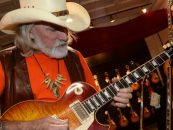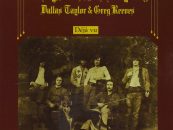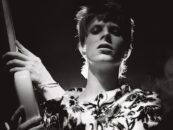 A new collection called Songs for Groovy Children: The Fillmore East Concerts, by Jimi Hendrix, was released Nov. 22 on CD and digital by Experience Hendrix L.L.C. and Legacy Recordings, a division of Sony Music Entertainment, with a vinyl release to follow on Dec. 13. This collection assembles all four debut concerts by Hendrix and the Band of Gypsys at the storied New York City venue in their original performance sequence. The 5-CD or 8-LP vinyl set boasts over two dozen tracks that have either never before been released commercially or have been newly pressed and newly remixed.
A new collection called Songs for Groovy Children: The Fillmore East Concerts, by Jimi Hendrix, was released Nov. 22 on CD and digital by Experience Hendrix L.L.C. and Legacy Recordings, a division of Sony Music Entertainment, with a vinyl release to follow on Dec. 13. This collection assembles all four debut concerts by Hendrix and the Band of Gypsys at the storied New York City venue in their original performance sequence. The 5-CD or 8-LP vinyl set boasts over two dozen tracks that have either never before been released commercially or have been newly pressed and newly remixed.
Listen to several performances and see the complete track listing below.
Watch the album trailer
Says a press release, “Over the course of four extraordinary years, Jimi Hendrix placed his indelible stamp upon popular music with breathtaking velocity. Measured alongside his triumphs at Monterey Pop and Woodstock, Hendrix’s legendary Fillmore East concerts illustrated a critical turning point in a radiant career filled with indefinite possibilities. The revolutionary impact Jimi Hendrix, Billy Cox and Buddy Miles had upon the boundaries and definitions of rock, R&B and funk can be traced to four concerts over the course of two captivating evenings. These performances were first celebrated by Band of Gypsys, which featured six songs from the two January 1, 1970, concerts, including ‘Machine Gun,’ the album’s dramatic centerpiece. Issued in April 1970, Band of Gypsys challenged and surprised the wide following of Jimi Hendrix with its extended arrangements and vibrant mix of rock and soul.”
Related: This collection is included in our 2019 box set gift guide
The announcement further states, “In June of 1969, at the height of their fame, the Jimi Hendrix Experience closed a musical chapter. Before the shockwaves could settle, Hendrix assembled a new, expanded ensemble to perform at Woodstock in August. A new chapter was opened as Hendrix introduced Gypsy Sun and Rainbows. The large ensemble included Jimi’s longtime friend Billy Cox, on bass, whom he had befriended when both were serving with the 101st Airborne Division in Ft. Campbell, Kentucky in 1962. This Woodstock lineup was short-lived; from its ashes a new trio emerged in October that Hendrix dubbed Band of Gypsys, consisting of Hendrix, Cox and Electric Flag drummer Buddy Miles, who would also contribute occasional lead vocals. Hendrix was inspired by his collaboration with Cox and Miles and this creative renewal drove the development of promising new material such as ‘Power Of Soul,’ ‘Burning Desire’ and the extraordinary ‘Machine Gun.’”
Their debut live performances were a series of four concerts at the Fillmore East in Manhattan, two on New Year’s Eve 1969 and two on New Year’s Day 1970, each of which were professionally recorded. Hendrix had sold out Madison Square Garden just nine months prior, but the Fillmore East was chosen as the setting for a live recording. Explains the press release, “Long before his fame, Hendrix had signed what he thought was a release for appearing as a studio musician in October 1965. Unfortunately, the one-page artist agreement drafted by PPX Industries bound his services for a period of three years. Unwilling to live hands tied, Hendrix agreed to a 1968 legal settlement whereby Capitol Records would be granted the distribution rights for his next album. By the autumn of 1969, Capitol and PPX were pushing hard for the album delivery and Hendrix decided to give them a live album.
“However stressful this legal obligation had been for the guitarist, the end result proved to be an artistic triumph. True to his unpredictability, Hendrix opened his four-show stint with a masterful, eleven song set that did not feature a single song he had commercially released. Exciting new songs such as ‘Izabella,’ ‘Ezy Ryder’ and ‘Burning Desire’ thrilled the sold-out house. Hendrix would pepper the remaining three shows with supercharged reworkings of favorites such as ‘Stone Free,’ ‘Purple Haze’ and ‘Fire’ but these were presented alongside such devastating, newly developed fare as ‘Machine Gun.'”
Listen to “Ezy Rider” from the second New Year’s Eve set
By the end of January 1970, the announcement continues, “the band was history, but the blend of funk, rock and soul pioneered by the trio became history, making a profound impact on popular music in its wake. Notable devotees include funk pioneers Parliament-Funkadelic, Curtis Mayfield, the Isley Brothers (with whom Hendrix himself had at one time played) and Bootsy Collins, extending all the way forward to hip-hop. Countless artists cite the record as a cornerstone in their appreciation of Jimi Hendrix ’s remarkable abilities.”
Related: Remembering Hendrix’s Greenwich Village days
The original 1970 Band of Gypsys album was edited and sequenced from songs performed during the two Fillmore sets on January 1, 1970. Subsequent collections mined more material from each of the performances with significant chunks of these phenomenal recordings from those nights sitting unreleased for almost half a century. Adds the announcement, “Newly mixed and restored in sequence without edits, fans can finally hear Hendrix, Cox and Miles blast through their genre-defying sets that included freshly written songs like ‘Earth Blues’ and ‘Stepping Stone,’ as well as Experience favorites inclusive of ‘Foxey Lady,’ ‘Voodoo Child (Slight Return),’ ‘Wild Thing,’ ‘Hey Joe’ and ‘Purple Haze.’ Additionally, exciting new versions of Howard Tate’s ‘Stop,’ ‘Steal Away,’ by Jimmy Hughes and a searing ‘Bleeding Heart’ by Elmore James highlighted the command that the trio had over blues and R&B music.”
Listen to “Foxey Lady” from the second set on Dec. 31
The package is filled with unseen photos from Fillmore East house photographer Amalie Rothschild, Jan Blom (whose color-saturated images provided the original artwork for 1970’s Band of Gypsys) as well as Marshall Amplifier representative Marc Franklin, who had full access to the group in their dressing room backstage. The booklet features remembrances from bassist Billy Cox and liner notes by author/journalist/filmmaker Nelson George. Songs for Groovy Children was produced by Janie Hendrix, Eddie Kramer and John McDermott, the trio that has overseen every project for Experience Hendrix since 1995. The boxed set was mastered by Grammy-winning engineer Bernie Grundman.
Listen to the previously unreleased “Message to Love,” from the second New Year’s Eve performance
Jimi Hendrix – Songs For Groovy Children: The Fillmore East Concerts 5-CD Track Listing
12/31/69 1st Set:
Disc One
1) Power Of Soul
2) Lover Man
3) Hear My Train A Comin’
4) Changes
5) Izabella
6) Machine Gun
7) Stop
8) Ezy Ryder
9) Bleeding Heart
10) Earth Blues
11) Burning Desire
12/31/69 2nd Set:
Disc Two
1) Auld Lang Syne%
2) Who Knows%
3) Fire
4) Ezy Ryder*
5) Machine Gun%
6) Stone Free
7) Changes*
8) Message To Love*
9) Stop*
10) Foxey Lady
1/1/70 1st Set:
Disc Three
1) Who Knows
2) Machine Gun
3) Changes+
4) Power Of Soul%
5) Stepping Stone%
6) Foxey Lady+
7) Stop%
8) Earth Blues+
9) Burning Desire%
1/1/70 2nd Set:
Disc Four
1) Stone Free%
2) Power Of Soul#
3) Changes#
4) Message To Love#
5) Machine Gun%
6) Lover Man*
7) Steal Away*
8) Earth Blues%
Disc Five
1) Voodoo Child (Slight Return)%
2) We Gotta Live Together#
3) Wild Thing%
4) Hey Joe*
5) Purple Haze*
*previously unreleased
+first time on CD/LP/streaming (previously only available as part of concert film)
#longer, unedited versions of previously released material, and newly remixed
%back in print on CD/LP for the first time in a decade, and newly remixed






2 Comments so far
Jump into a conversationSONGS FOR GROOVY CHILDREN DOES NOT CONTAIN THE COMPLETE FOUR BAND OF GYPSYS FILLMORE CONCERTS…While Hendrix fans have clamored for the legendary Band of Gypsys Fillmore East concerts, Sony and Experience Hendrix have opted to purge Hendrix history on this release, omitting some of the songs that they felt were not representative of Hendrix as he was badly out of tune.
What stands as a legendary landmark in rock music history are four concerts performed by Jimi Hendrix, Billy Cox and Buddy Miles – the Band of Gypsys – on December 31, 1969 and January 1, 1970. Not only putting an exclamation point on the close of the 60s rock music history, but offering a birth of the changes rock music was heading in the 70s. Even though the Band Of Gypsys only lasted a period of four months, and only performed one more abbreviated concert after these Fillmore shows, they have been heralded as one of the most impactful periods of Hendrix’s career. Fans have called out for their induction into the Rock and Roll Hall of Fame. Just this year, the group with inducted into the Rhythm and Blues Hall of Fame. And authors Corey Washington and Nelson George have written volumes on how the group has impacted generations of predominately black-oriented audiences and musicians alike.
So it with great fanfare that Experience Hendrix has compiled the four shows in the new box set, being released as both a 5-CD and 8-LP package, Songs for Groovy Children. The name of the album comes from a remark Hendrix made right before they break into “Power of Soul” in their final show. The package comes complete with the band’s story told by Billy Cox, along with an essay by Nelson George demonstrating the impact it had on him and black audiences.
Over the years, bits and pieces of these concerts have been released, this being the first comprehensive, albeit still incomplete, package of the four iconic concerts. There are 13 new, never before commercially released songs, as well as two songs which have never appeared either commercially or through collector unauthorized editions. Overall, there are over two dozen tracks “that have either never before been released commercially or have been newly pressed and newly remixed,” according to the project press release. The package is filled with unseen photos from talent such as Fillmore East house photographer Amalie Rothschild, Jan Blom (whose iconic, color saturated images provided the original artwork for 1970’s Band of Gypsys) as well as Marshall Amplifier representative Marc Franklin, who had full access to the group in their dressing room backstage.
As the Band of Gypsys project only lasted four months, in reality, it was not meant to be a long-term project for Hendrix.
Billy Cox tells the story of how the Gypsys came to Jimi’s aid in his times of legal troubles in the liner notes in the Groovy set. “He (Jimi) was being sued for money that he didn’t have. He was down in the dumps and said, ‘what am I going to do, Billy?’ I said well, give them something. It was decided in a couple days that we would record a live album to give them and that’s how it came to be.” With Mitch and Noel unavailable, “Buddy was readily available because he hung out with us. We would up telling Jimi’s management team what he wanted to do so they said, OK great. This will get him off the hook.”
As a reaction to the band’s induction into the Rhythm and Blues Hall of Fame, Cox noted how he was proud of the acknowledgement, but also said, “When he (Jimi) first came to me with the problem, I told him I was there to help. Jimi tried to get others who had played with him to help or some of his ‘friends’ but all refused him. They refused because there was no money to be made except for what the gig paid that night. Buddy Miles volunteered to help also. The agreement was for a ONE album deal only.” He continues, “Let’s not get it twisted, the BOG began as a rescue effort for a friend,” and never necessarily intended for a long-term evolution.
Well, that one album deal has evolved into the eighth time material from the Band Of Gypsys’ concerts has been released (even though two unauthorized). In 1970, Capitol issued the first album in a resolve to the Ed Chalpin lawsuit, with six songs pulled from the two shows on January 1. More than a decade later, Capitol tried to capitalize on the interest in the Band Of Gypsys, offering up a highly misrepresented album of the group as Band Of Gypsys 2 in 1986. However, of the six songs on that album, only three were actually the Band Of Gypsys – “Hear My Train A Comin’” from the first show New Year’s Eve along with “Foxy Lady” and “Stop” from the first show on January 1 – while the other three songs were pulled from the 7/4/70 Atlanta Pop Festival and 5/30/70 Berkeley Community Center concerts that didn’t feature the Gypsys. Adding to the insult, a mis-pressing of that album hit stores. On that one, side two features “Hey Joe”, “Hey Baby (Land of the New Rising Sun)”, “Ezy Rider”and “Lover Man” from the Berkeley shows instead of “Voodoo Chile”, “Stone Free” and “Ezy Rider”.
In 1991, the original Band of Gypsys album was re-issued in England on CD by Polydor, this time adding three bonus tracks ironically, the three tracks that appeared on the Band of Gypsys 2 album.
As the licensing and distribution of the Hendrix catalog moved to MCA in the mid-90s, that label offered an “expanded” Live at the Fillmore East in 1999 serving up 16 songs from the four performances.
17 more years passed, distribution of the Hendrix catalog moved to Sony/Legacy, and Experience Hendrix teamed with the label to present the complete first show from the New Year’s Eve concerts as Machine Gun: The Fillmore East First Show 12/31/1969.
Those are the previous commercial releases. But there are also two unauthorized box sets that can’t be overlooked. In 2002, a 6-CD set Box of Gypsys was released on the Marshall label. And five years later an identical set was released as 2 Nights at the Fillmore on the Voodoo Chile label, claiming to be manufactured “under license from the Michael Jeffery Estate” (although Experience Hendrix later obtained an infringement writ against the label). Those releases include the five missing songs from this Songs for Groovy Children release. And while those were thought as “complete,” the new release includes two songs from the final Fillmore show – “Lover Man” and “Steal Away”. The latter is a song never before heard performed by Hendrix, a slow 12-bar blues song that was originally a hit for Jimmy Hughes in 1964.
Let’s take a closer look at Songs for Groovy Children, as with tapes and unauthorized releases that have circulated demonstrate there are portions of the performances missing.
While Hendrix fans are elated to see that the four legendary Band of Gypsys performances at the Fillmore East on December 31, 1969 and January 1, 1970 are being released; it is with disappointment to discover this release does not include the complete performances of the four concerts. It appears Experience Hendrix has, like the previous 2009 MCA/2010 Sony Live at Woodstock release, opted to purge history deleting five songs from the second show on New Year’s Eve that they apparently have felt are not representative of the group.
Sending out pre-release press on Songs For Groovy Children, “this collection assembles al four historic debut concerts…in their original performance sequence.” Being released in both 5-CD and 8-LP box sets, one would believe this would be the complete performances, but nowhere in the press releases is the word “complete” included.
In taking a look at the release, it appears five songs from the second set – “Stepping Stone”, “Burning Desire”, “Power of Soul” and the closing “Voodoo Chile (Slight Return)” and “Purple Haze” – have been omitted.
Knowing that these songs were recorded, and have been included on unauthorized releases, when we asked why they are missing, we were told, “The bootlegs make clear what and why in terms of songs that have tuning problems, etc.” And we have to admit, that’s true. Back in those days, there were not guitar tuners, multiple guitars on stage, or a roadie bringing a new guitar out for every song; as is so commonplace today. Hendrix had to work with the tool that was in his hands, and with the stress he put on the instrument, there was no way it would stay in tune for the duration of a concert, let alone doing two shows a night until the early hours of the next morning had to be fatiguing. Still, we certainly expect the diehard Hendrix legions of fans to cry “foul,” as they have experienced many of Hendrix’s live performances where Hendrix misses a note yet makes the mistake work, and would want the complete history included “warts and all.”
Hendrix historian Kees DeLange has assisted in analyzing the material that is included on this release to evaluate the differences. “Two songs have been radically edited – ‘Foxy Lady’ from the second show on December 31 is now the finishing song omitting the last six minutes or so, and is identical to the track that was included on the West Coast Seattle Boy release,” going on to comment, “This part is indeed a bit shaky but on the other hand nothing if left of Jimi’s improvisations and some nice parts could have easily been left in.” The other track with edits is “We Gotta Live Together” which is exactly the same as on the 1998 release Live at the Fillmore East. “The parts where Buddy is inviting the audience to participate could have been represented better especially because Jimi is playing some nice accompanying guitar,” says DeLange, even though it’s admitted Miles rambles on endlessly during this passage.
“On the other hand the complete versions of ‘Power of Soul’ and ‘Changes’ shed a very welcome light on the editing choices Hendrix made in 1970,” notes DeLange. “By skipping the more tentative parts the performances gained a lot of strength and coherence. They also benefitted from the fact they were sped up a little.
“Roughly the following sequences were eft out of ‘Power of Soul’ – 0:20-1:40, 5:10-5:40 and 6:55-7:15. In those Jimi’s playing sounds a bit insecure. The Songs for Groovy Children version sounds totally different is is therefore nice to have.”
As “Changes” is Buddy Miles’ trademark, he took center stage on the song, taking it well beyond what was probably necessary with Hendrix allowing him his time in the spotlight. So for the atypical consumer, a large portion of this song has been spliced out, “the sequence from 3:30-7:20 which were radically cut back in 1970.”
Because of the improved fidelity on Songs for Groovy Children over previous releases, DeLange notes “The version of ‘Machine Gun’ from Live at the Fillmore East actually sounds better because the small out of tune sections are a lot more noticeable on Songs for Groovy Children.”
The new mix on the first show also seems more open than it was on the Machine Gun release which seemed compressed and limited.
What is exciting is a brand new track that had never been heard, and is a song that has never appeared in the Hendrix archive with the Band of Gypsys doing the Jimmy Hughes song “Steal Away”, as well as their take on “Lover Man” from the second show on January 1.
Overall, Songs for Groovy Children is a welcome addition to the Hendrix catalog. As DeLange finishes with a final comment, “I like it very much. It’s revealing and honest. Personally I think the set works want if you want to show a general audience what the significance of the Band of Gypsys really is.”
The two sets are being released a couple weeks apart with the 5-CD and digital streaming formats being issued on November 22 with a retail cost $59.98, and the 8-LP vinyl set coming out December 13 with a retail of $119.98 in time for the holiday shopping season. Here’s the trailer for the release – https://www.youtube.com/watch?v=GQDT52e5Hdg – and here’s a preview of “Foxey Lady” from the second set on December 31 that has been offered – https://youtu.be/8c7hPSPHlwY and a clip of Buddy Miles discussing the formation of the Band of Gypsys – https://youtu.be/um2-XDCVIM4
thank you for this information! I thank Sony for this release, though it makes me wonder if there is (or will be someday) some kind of software that could ‘re-tune’ Hendrix’ out-of-tune guitar in the mastering studio so that they would release all tracks. Similar but not as thorough software already exists